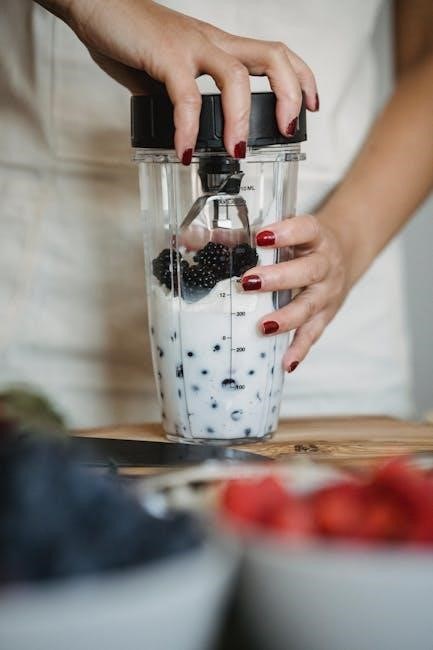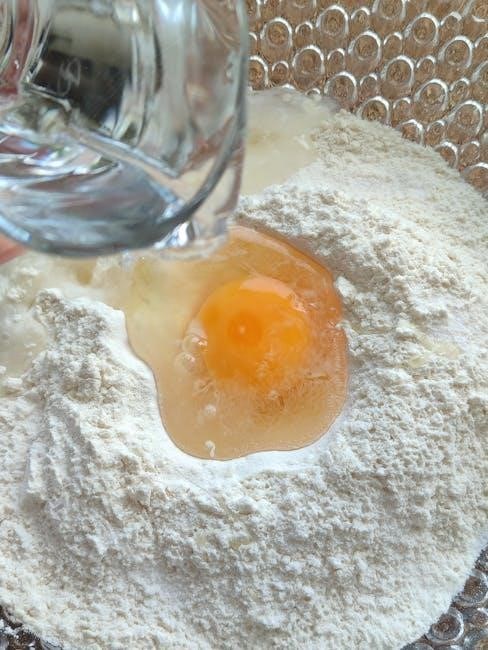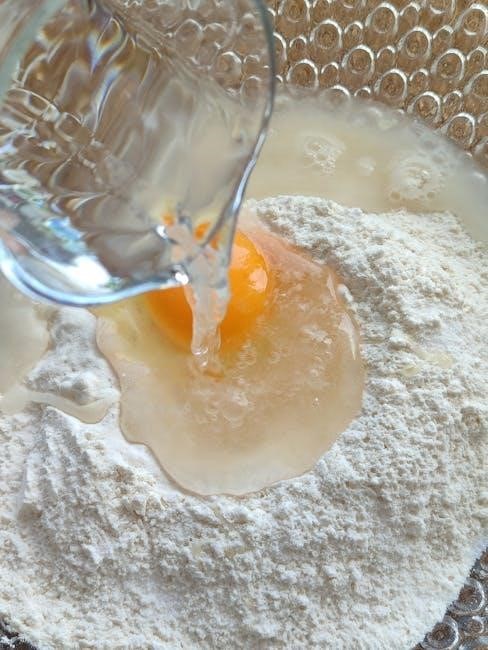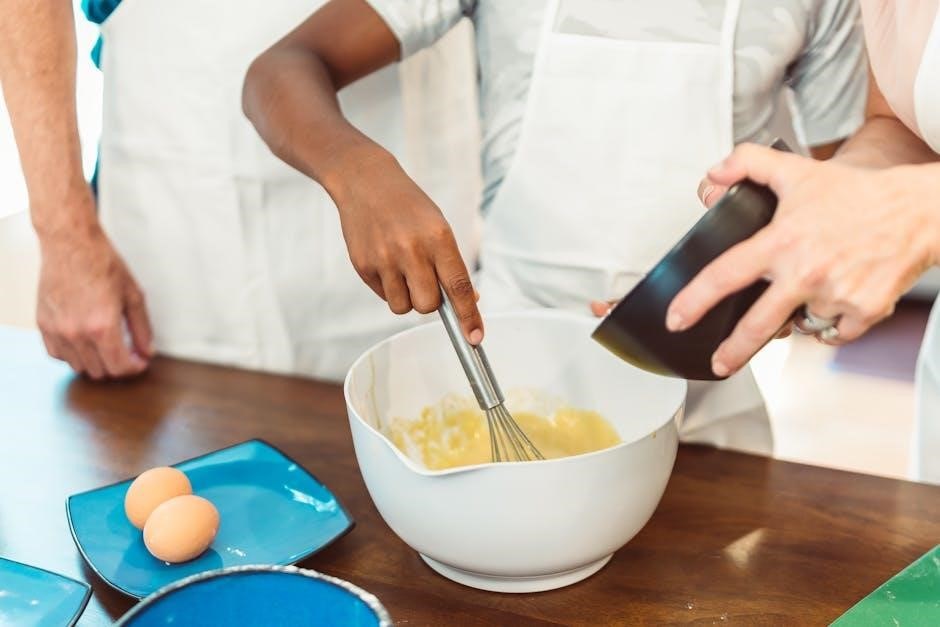Proper mixing of IGF-1 LR3 is crucial for maintaining its potency and ensuring effective results; This guide provides step-by-step instructions for safe and accurate reconstitution.
1.1 Importance of Proper Mixing Techniques
Proper mixing techniques are crucial to maintain the stability and bioactivity of IGF-1 LR3. Improper methods can lead to contamination, uneven concentration, or degradation of the peptide, reducing its effectiveness. Accurate reconstitution ensures consistent dosing and prevents waste, making it essential for achieving desired research or therapeutic outcomes.
1.2 Overview of IGF-1 LR3 and Its Benefits
IGF-1 LR3 is a synthetic peptide with enhanced potency and longer half-life compared to natural IGF-1. It promotes muscle growth, fat loss, and recovery by stimulating muscle protein synthesis. Its benefits include accelerated muscle gains, improved recovery post-workout, and reduced inflammation, making it a popular choice for research and therapeutic purposes.
Materials Needed for Mixing IGF-1 LR3
The essential materials include bacteriostatic water USP, sterile syringes, needles, and the IGF-1 LR3 powder vial. These ensure safe and effective reconstitution of the peptide.
2.1 Bacteriostatic Water USP
Bacteriostatic Water USP is a sterile, non-pyrogenic solution containing 0.9% benzyl alcohol. It is specifically designed for reconstituting lyophilized peptides like IGF-1 LR3. This water inhibits bacterial growth, ensuring the solution remains stable and safe for injection over multiple uses. Always use bacteriostatic water to maintain the integrity of the peptide during mixing.
2.2 Syringes and Needles
Use a 1cc syringe with a 29-30 gauge needle for precise measurement and injection. The smaller needle size minimizes discomfort and prevents excessive foaming during reconstitution. Always use sterile syringes and needles to ensure safety and avoid contamination. Replace the needle after reconstitution to maintain accuracy and prevent peptide degradation.
2.3 Vial of IGF-1 LR3 Powder
The vial contains 1mg of lyophilized IGF-1 LR3 powder. Store it in a cool, dry place before reconstitution. Ensure the vial is sealed tightly to prevent contamination and exposure to light. Handle the vial with care to avoid accidental breakage. The powder is sensitive to temperature fluctuations, so refrigerate it if not used immediately.
Step-by-Step Reconstitution Process
Reconstitute IGF-1 LR3 powder by adding bacteriostatic water, gently swirling, and allowing it to dissolve fully for optimal bioavailability and effectiveness in research or therapeutic applications.
3.1 Calculating the Appropriate Amount of Solvent
Calculate the solvent amount based on the peptide concentration. A standard ratio is 1mg of IGF-1 LR3 to 1ml of bacteriostatic water. Use an insulin syringe for precise measurement. Ensure the volume aligns with the vial’s capacity and desired concentration. Accurate calculation prevents overly diluted or concentrated solutions, which can affect dosing and efficacy.
3.2 Injecting Bacteriostatic Water into the Vial
Gently inject the calculated amount of bacteriostatic water into the IGF-1 LR3 vial using a sterile syringe. Avoid forceful injection to prevent foaming. Hold the vial at a slight angle and insert the needle through the rubber stopper. Slowly release the water, ensuring it flows evenly around the powder. This method minimizes air bubbles and promotes smooth reconstitution.
3.3 Gently Swirling the Mixture
After injecting the bacteriostatic water, gently swirl the vial in a circular motion. Avoid vigorous shaking, as this can damage the peptide. Continue swirling until the powder is fully dissolved and the solution appears clear. This ensures even distribution and prevents air bubbles from forming. Let the mixture sit for a few minutes before use to ensure complete reconstitution.

Storage and Handling of Mixed IGF-1 LR3
Refrigerate the mixed solution at 36-46°F to maintain potency. Avoid freezing. Shelf life is typically 2-4 weeks after reconstitution. Store in a sealed, labeled vial.
4.1 Refrigeration Requirements
Reconstituted IGF-1 LR3 should be refrigerated at a temperature between 36°F and 46°F (2°C to 8°C). This ensures the stability and potency of the solution. Avoid freezing, as it can degrade the peptide. Always store the vial in a sealed container to prevent contamination and exposure to light.
4.2 Shelf Life After Reconstitution
The shelf life of mixed IGF-1 LR3 is typically 4-6 weeks when stored properly in the refrigerator. Ensure the vial is kept at a consistent refrigerated temperature to maintain potency. Discard any solution that appears cloudy, discolored, or shows signs of contamination. Always follow proper handling and storage techniques to maximize the peptide’s effectiveness.


Dosage and Administration Guidelines
Proper dosage and administration are vital for maximizing IGF-1 LR3’s benefits. Follow recommended guidelines to ensure safe and effective use, optimizing muscle growth and recovery.
5.1 Recommended Daily Dosage
The recommended daily dosage of IGF-1 LR3 typically ranges from 50-100mcg, divided into 1-2 injections. Start with a lower dose to assess tolerance, then gradually increase as needed. Consistency is key for optimal results, ensuring the peptide works effectively within the body. Always follow a healthcare provider’s advice for personalized dosing.
5.2 Timing and Frequency of Injections
Administer IGF-1 LR3 injections subcutaneously, typically once or twice daily. Optimal timing is post-workout or before bed to maximize recovery and growth. Consistency in timing enhances bioavailability and ensures steady peptide levels in the bloodstream, supporting muscle repair and growth throughout the day.
Factors Influencing Mixing and Dosage
Concentration, individual tolerance, and peptide-to-solvent ratios significantly impact mixing and dosing accuracy. Proper calculation ensures optimal bioavailability and effectiveness of IGF-1 LR3.
6.1 Concentration of the Solution
The concentration of the solution is determined by the ratio of IGF-1 LR3 powder to bacteriostatic water. A standard ratio is 1mg of peptide to 1ml of solvent, ensuring easy measurement. Adjusting the volume based on vial size and desired dosage is crucial. Precise calculation ensures optimal bioavailability and effectiveness, avoiding under- or over-concentration, which can impact results and safety.
6.2 Individual Tolerance and Response
Individual tolerance plays a key role in determining the appropriate dosage and response to IGF-1 LR3. Starting with a lower dose helps assess sensitivity and minimize side effects. Dosage ranges vary from 10-20mcg for low tolerance to 50-100mcg for experienced users. Cycling protocols, such as 6 weeks on and 6 weeks off, can prevent desensitization. Personalized adjustment ensures safety and maximizes benefits.

Safety Precautions and Handling Tips
Use sterile equipment and bacteriostatic water to prevent contamination. Avoid shaking the vial; gently swirl instead. Store mixed solution in the refrigerator to maintain potency and safety.
7.1 Sterility and Hygiene Practices
Maintaining sterility is crucial when mixing IGF-1 LR3. Use bacteriostatic water and sterile syringes to minimize contamination risk. Ensure all equipment is clean, and always wear gloves. Avoid touching the needle tip or vial septum. Work in a sanitized environment to prevent bacterial growth and ensure the solution remains safe for use.
7.2 Avoiding Overmixing or Shaking
Avoid vigorous shaking or overmixing the IGF-1 LR3 solution, as this can damage the peptide structure and reduce its effectiveness. Instead, gently swirl the vial in a circular motion to ensure even distribution. Allow the solution to dissolve naturally; shaking may create foam or bubbles, which can compromise the integrity of the mixture and its potency.
Common Mistakes to Avoid
Incorrect solvent volume and improper swirling techniques are common errors. These mistakes can compromise the peptide’s structure, leading to reduced potency and effectiveness. Precision is key.
8.1 Incorrect Solvent Volume
Using too much or too little bacteriostatic water can alter the concentration of the IGF-1 LR3 solution. This can lead to inconsistent dosing and reduced potency. Always measure the exact recommended volume to maintain the correct concentration and ensure optimal results. Proper calculation is essential to avoid wasting the peptide or rendering it ineffective.
8.2 Improper Swirling Technique
Aggressive swirling or shaking the vial can damage the peptide structure, reducing its effectiveness. Instead, gently swirl the mixture in a circular motion to ensure even dissolution. Avoid vigorous agitation, as it may denature the protein. Proper swirling ensures the IGF-1 LR3 dissolves fully, maintaining its bioactivity and ensuring accurate dosing for optimal results.

Troubleshooting and FAQs
Address common issues like cloudy solutions or improper mixing. FAQs cover topics such as storage, handling, and best practices for reconstitution to ensure safety and efficacy.
9.1 What If the Solution Appears Cloudy?
If the solution appears cloudy after mixing, ensure all powder is fully dissolved. Allow it to sit for 10 minutes without shaking. Gently swirl the vial to mix thoroughly. Cloudiness typically resolves on its own. If it persists, check for proper reconstitution techniques or consult a professional for guidance to ensure solution integrity and potency.
9.2 Can I Use Different Types of Water?
Bacteriostatic water is recommended for reconstituting IGF-1 LR3 due to its sterile properties and preservatives, which prevent contamination. Avoid using non-bacteriostatic water, as it may reduce shelf life and increase infection risks. Sterile distilled water can be an alternative if bacteriostatic water is unavailable, but ensure it is free from additives to maintain solution stability and peptide integrity.

Proper mixing and handling of IGF-1 LR3 ensure safety and effectiveness. Always use bacteriostatic water, store reconstituted solutions chilled, and follow guidelines for optimal results and benefits.
10.1 Summary of Key Points
Proper mixing involves bacteriostatic water and gentle swirling. Store reconstituted solutions refrigerated, protected from light. Dosage guidelines vary, starting low to assess tolerance. Always follow safety protocols and consult professionals for personalized advice to ensure safe and effective use of IGF-1 LR3.
10.2 Final Tips for Successful Mixing
Always use bacteriostatic water to maintain sterility. Calculate solvent volume precisely for desired concentration. Swirl gently to avoid foam formation. Allow the solution to sit for a few minutes before use. Store reconstituted vials refrigerated at 2-8°C. Ensure clarity before administration and discard if cloudy. Follow these tips for optimal results and safety when mixing IGF-1 LR3.
Additional Resources and References
Refer to peer-reviewed journals and official medical websites for detailed guidelines. Explore forums and expert blogs for shared experiences and tips on IGF-1 LR3 preparation and use.
11.1 Recommended Reading
For in-depth understanding, read peer-reviewed journals on peptide science and official medical websites. Explore detailed guides on IGF-1 LR3 from reputable manufacturers and scientific publications. Additionally, refer to instructional pamphlets from trusted laboratories and forums where professionals share insights and practical tips for optimal mixing and administration practices.
11.2 Where to Find Reliable Information
Visit trusted websites like NCBI, PubMed, and official peptide manufacturer sites for accurate information. Scientific forums and professional health communities also provide valuable insights. Always verify sources for credibility and medical accuracy to ensure safe and effective use of IGF-1 LR3.
